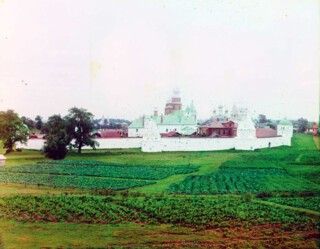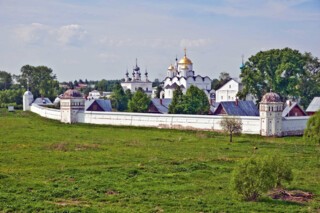In the decade or so before the revolutions of 1917, the photographer Sergei Prokudin-Gorsky crisscrossed the Russian empire on its growing network of railways. He visited the medieval towns of Yaroslavl and Smolensk, went deep into Siberia and north to the Solovetsky islands, and travelled south to Bukhara and Samarkand, Central Asian cities colonised over the preceding century. He photographed churches and monasteries, factories and waterways, landscapes and natural wonders, famous people (Tolstoy, the emir of Bukhara), peasant girls and factory workers. He travelled in style, with his own carriage, half of which contained his bespoke darkroom. The Ministry of Transport did its best to accommodate the unusual traveller and his considerable baggage. He was, after all, a man of importance: Tsar Nicholas II had received him personally in 1909 and requested more of his striking colour images. But Prokudin-Gorsky also had a wider audience in mind. His goal was to reveal the diversity and richness of the empire to audiences in St Petersburg and Moscow. With that aim, he put together a series of colour postcards for sale and gave frequent slide demonstrations to the public.
In 1970, an American graduate student set off for what was then the Soviet Union, taking a camera he’d bought for the trip. William Craft Brumfield spent the next half-century travelling through the Soviet Union and its successor states, becoming a specialist in the region’s architectural history and a respected photographer in his own right. Along the way, he developed an interest in the work of Prokudin-Gorsky. He visited and photographed many of the same sites, and in Journeys through the Russian Empire he brings the two collections together. The juxtaposition of the newer photograph with the old, often taken from the same angle, captures the twilight, and in one case the aftermath, of two empires – the Romanov dynasty and the USSR.
Rather than attempt an overview of the entire Prokudin-Gorsky collection, Brumfield concentrates on religious buildings. His selection includes Prokudin-Gorsky’s portraits of individual churches and monasteries, and – in one chapter – mosques and madrasas. He also includes a striking urban panorama of the Siberian city of Perm, taken in 1909, with its cathedral, mosque, railway bridge, foundries billowing smoke, steamers and barges on the Kama river. This is a city undergoing rapid industrialisation, a dynamism caught in the smoke moving across the skyline.
For the most part, however, Prokudin-Gorsky’s pictures have a static quality. The process he used to produce colour photographs required a relatively long exposure, making it impossible to capture the bustle of a city scene. His pictures of religious buildings were shot at quiet times: in the market town of Borisoglebsky, for example, he photographed the Rostov monastery before the market stalls had been set up. Without people or movement, these pictures seem timeless. Although in other photographs Prokudin-Gorsky sought to capture some of the great transformations underway in the early 20th century – new railways and waterways – his depictions of churches and monasteries, often set against a rural backdrop, suggest an unchanging country. The vividness of the colour images, and the nostalgia of their composition, explains the interest Prokudin-Gorsky’s photographs have attracted in recent decades, as Russians look for alternatives to the Soviet legacy.
What happened to this pre-Soviet heritage in the decades after 1917? Is this really a Russia that was ‘lost’? On first viewing, the two journeys presented in this collection suggest not. Brumfield was able to re-create set pieces that differed little from those of his predecessor: the same church still stands, sometimes crumbling or missing parts, sometimes restored, but always recognisable. Photographs of the town of Suzdal, taken almost a century apart, show few signs of change: green fields and low wooden houses still surround the Intercession Convent, with no evidence of a Soviet imprint. The new industrial centre of Yaroslavl was built to the west of the old city, so the religious buildings photographed by Brumfield are still bordered by the trees we see in Prokudin-Gorsky’s images. There are exceptions: Brumfield’s shots of Yekaterinburg show a city transformed, the Cathedral of Saint Catherine destroyed and the district court overshadowed by Soviet blocks and post-Soviet skyscrapers.
The impression that Russia emerged largely unscathed and unchanged from the Soviet years feels wrong, of course. The revolution was meant to bring a grand transformation of every aspect of contemporary life, one that could only be achieved by destroying the old. Religion – its practices, places and people – was certainly part of the ‘old’ world. The most famous church to be destroyed was the Cathedral of Christ the Saviour in Moscow. Built to celebrate the retreat of Napoleon in 1812, it was dynamited in 1931. Stalin intended a great new Palace of the Soviets to replace it. A national competition was launched to find a design but the project was eventually shelved in favour of an enormous public swimming pool: a holy site made into a palace of leisure for the masses. Prokudin-Gorsky chose not to photograph either St Petersburg or Moscow, so the church doesn’t feature in this book, and as a result the pairs of images, all of provincial outposts, seem to tell a story of continuity rather than rupture. Yet once you get past the often striking similarities between the two sets, a more complex story emerges. In the Soviet era, religious buildings faced many possible fates. There were certainly episodes of violent destruction, but also of neglect, reappropriation and restoration, and these phases overlapped and intertwined, reflecting an attitude to religion and its heritage that was above all inconsistent.
The anti-religious struggle began during the Revolution and the Civil War, when the Bolsheviks targeted the wealth and infrastructure of organised religion, especially the Russian Orthodox Church. The year 1929 is often referred to as the ‘great breakthrough’ because of its breathtaking targets for industrial output and collectivisation, but it also saw the intensification of the state’s anti-religious measures. In the Russian republic, a quarter of Orthodox churches were closed in just two years. The onion domes of the Cathedral of the Deposition in Suzdal, which Prokudin-Gorsky photographed in 1912, were destroyed in 1929 when the building was converted into a power station, supplying electricity to a nearby prison. The baroque Cathedral of Saint Catherine in Yekaterinburg was demolished in 1930. Such iconoclastic acts were typical of those years. Sometimes churches were dismantled more stealthily. At Borodino – where Napoleon was pushed back in 1812 – much of the village was burned to the ground when the German army retreated in 1942. The church’s bell tower survived, but was taken apart piece by piece by the chairman of a local collective farm, who was desperate for bricks to use in postwar reconstruction. The ruin of churches could also be a form of collateral damage. In 1961, the village of Krokhino was flooded when a new reservoir was created. Left standing precariously on the water’s edge, the Church of the Nativity of Christ gradually collapsed. The most common fate was for places of worship to be stripped of their valuables and put to other uses. Monasteries and churches became prisons, old people’s homes and warehouses. The mosque in Perm was used to house the local Communist Party archive. In the town of Vytegra, the cathedral lost its bell tower and cupolas, gained larger windows and became the local club, where meetings, social events and film screenings were held. Interestingly, as the historian Catriona Kelly has noted, church buildings in the USSR were never appropriated for housing, though this has been happening in Western Europe since the 1960s. What Kelly called a ‘sense of the sacral’ seems to have remained.
Conflicting impulses were at work. Buildings were required to house prisoners, or grain; bricks were needed for new structures; gold was taken from cupolas to boost the state coffers. There were political aims too. Destroying or disfiguring sites of worship demonstrated not only their obsolescence, but also the power of communism to bring about transformation. Once the violence ended, the preferred narrative of the Soviet authorities – that of overturning the Church’s tyranny – risked being forgotten. At the height of Stalin’s cultural revolution, the destruction of churches, including Christ the Saviour, was captured on film in a bid to preserve the moment.
An alternative to destruction – which was costly and time-consuming – was to preserve religious buildings but change their meaning, flip them from places of worship into sites of atheist learning. Museums of atheism were opened in former churches and mosques from the 1920s onwards, but especially in the Khrushchev era, which saw the launch of new offensives against religious activity. Displays showed visitors scenes of the misery inflicted throughout history in the name of religion. At the Kazan Cathedral in St Petersburg, Roman Catholicism was represented by a diorama depicting a medieval torture chamber with a prisoner on a rack. Religion became a closed chapter in human history, a horror to be gawped at, a barbarism unimaginable in the present day. In this manner, the heuristic function of the building’s desacralisation was re-enacted each time a school group or coach of tourists visited. But attitudes to religion continued to shift, and by the 1980s, many displays were being reworked to give a rosier view of Russia’s religious past.
In fact, as Journeys through the Russian Empire quietly illustrates, the desire to preserve religious buildings as part of a national past was not solely a phenomenon of perestroika. Preservationists were active throughout the Soviet period, and even if their efforts were sometimes overwhelmed by waves of violent anti-religious activity, the idea that religious buildings had an intrinsic cultural and aesthetic value never entirely went away. Local efforts to preserve these buildings were often successful. The chairman of the collective farm at Borodino was eventually forced to stop pilfering bricks from the church by historians and preservationists. In the 1960s, the film director and actor Sergei Bondarchuk was instrumental in campaigning for the restoration of the church’s exterior, including its bell tower, which featured in his movie version of War and Peace. Several of the religious buildings photographed by Brumfield were restored while Khrushchev and Brezhnev were in power: in the 1950s, the Nativity Cathedral in Suzdal; in the 1960s, the Church of St Peter and St Paul in Smolensk and the Transfiguration Monastery on Solovetsky Island, as well as other buildings in Suzdal after the town was made a national cultural landmark in 1967; in the 1970s, the Archangel Cathedral in Ryazan; and so on. The desire to preserve a national past was felt beyond Russia, too. In Central Asia committees were formed in the 1920s to preserve historic buildings, including madrasas, and although preservation work faltered in the 1930s, new initiatives were launched in the 1950s, with work beginning in earnest in the early 1960s. The Miri Arab Madrasa in Bukhara and the Gur Emir in Samarkand (the burial place of Tamerlane) – shown in the penultimate chapter of Journeys through the Russian Empire – both underwent extensive restoration during the Soviet era.
This is all quite different from the story of Christ the Saviour in Moscow, which seems to follow the arc of communism’s rise and fall. When Soviet power ended, the cathedral was rapidly rebuilt, once more serving the religious needs of the capital’s political and cultural elite. As such it also became a site for protest – Pussy Riot staged a guerrilla performance of their ‘Punk Prayer’ here in 2012. Yet the fate of the religious buildings surveyed in Journeys through the Russian Empire shows that the pattern of church destruction in the Stalin era and recovery after the fall of communism was not universal. The question of what to do with religious buildings was unresolved throughout the Soviet era. Blowing them up was appealing to the Bolsheviks, but so was protecting them as symbols of national heritage and pride; or preserving them while transforming their use and meaning, turning them into props for the story of communism’s secular triumph – a fragile narrative that had to be constantly retold. Contemporary Russia may like to see itself as the saviour of a religious tradition all but obliterated by the communists, but this too is a fragile narrative. The traces that survive suggest a less straightforward history.
Send Letters To:
The Editor
London Review of Books,
28 Little Russell Street
London, WC1A 2HN
letters@lrb.co.uk
Please include name, address, and a telephone number.



